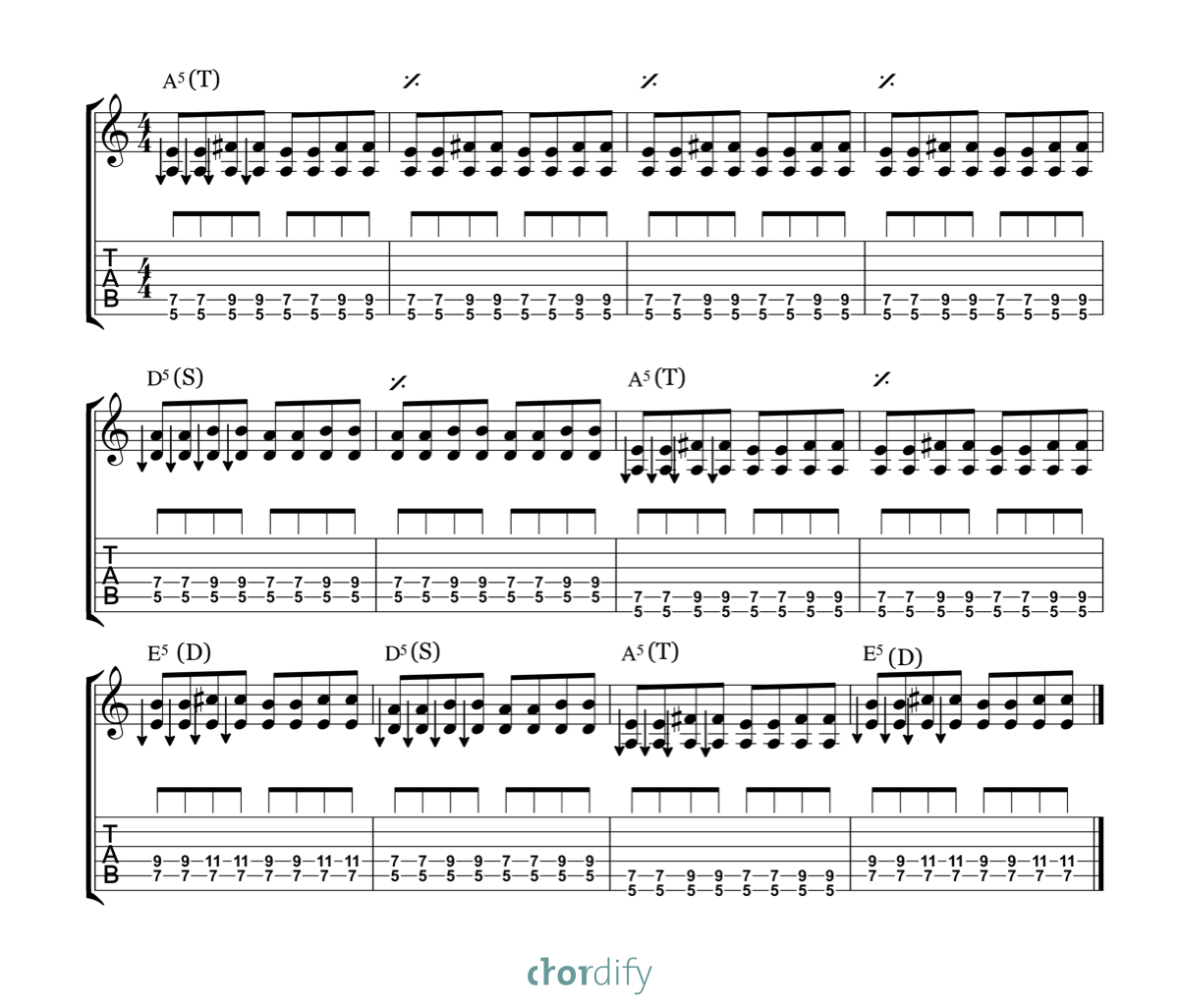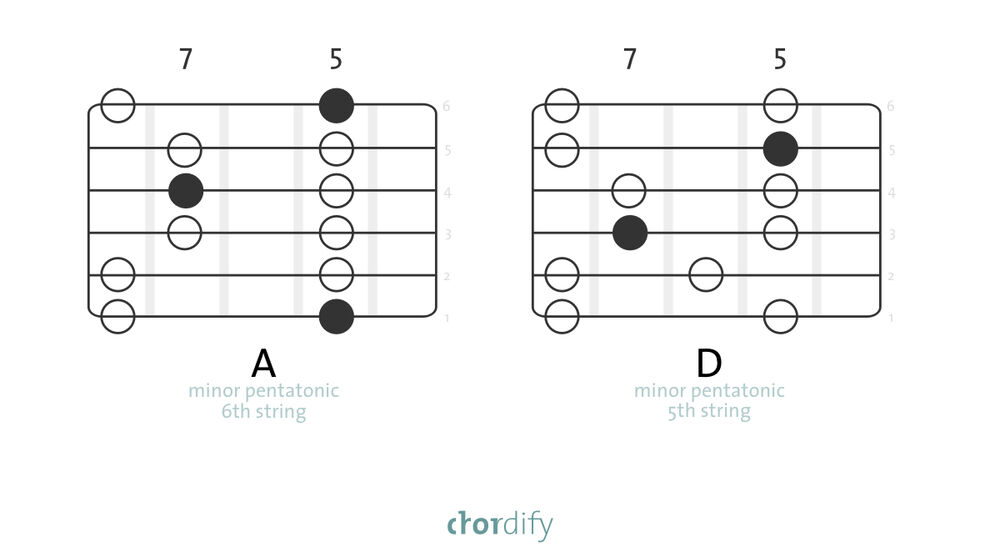Do you want to learn how to play rock ’n’ roll? Great, this the Chordify School of Rock and you’re at the right place. In this blog post we’ll show you how a rock ’n’ roll song is composed, and how you can join and play any rock ’n’ roll song. We’ll also dive into some simple tricks on how to play a power chord. And, last but not least, we’ll teach you a simple way to play a solo, once you understand the chord structure of a song.
Estimated reading time: 11 minutes
In this School of Rock blog post
Main takeaway
Being influenced by blues, rock ’n’ roll follows more or less the same song structure, which consists of three main chord types. It doesn’t matter what sound the chords are, they have one thing in common: one is the tonic, the other is the subdominant, and the third is the dominant chord. We’ll explain them all below. Here’s a heads up: There is going to be a lot of theoretical jargon.
We’ll use the terms and clarify them afterwards so you can get acquainted with them. But don’t get scared if there is something you don’t understand, even practiced musicians don’t know everything all the time. The main takeaway from this article is that rock ’n’ roll follows a certain formula. Once you know that formula, you can explore the rock universe all you want.
After you’ve absorbed this knowledge you’ll be ready to jump on the table and bounce around, firing one rock ’n’ roll riff after the other, Chuck Berry style. That will get your grandma slippin’ and slidin’ for sure. So, go for it and move your body to the rhythm!
Chord structure for rock ’n’ roll
Let’s take a closer look at the chord structure of basic rock ’n’ roll songs. For starters, we have the tonic chord (T): This is our “home,” our starting point. It is a key-center of the whole rock ’n’ roll, and we give it the roman numeral: I.
The tonic chord is followed by the subdominant chord (S): This is the route we take when we’re going out of our home for a walk. When we’re playing this chord, we do not have a strong tendency to go back to the tonic chord. We give the subdominant the roman numeral: IV.
Last but not least, we have the dominant chord (D): This is when we’re walking around and see a familiar road we know leads back home — just over the hill. When you get this feeling, it means the rock ’n’ roll song has arrived at its dominant chord. We just feel strongly inclined to go back to the tonic chord. The dominant also has a special roman numeral: V.
What kind of chords are these, you might ask. It’s a bit complicated, but to answer your question: These are major seventh chords. If you don’t know what seventh chords are, don’t freak out. There is an easy way to play them as triads. Even better, in this article we’ll show you another way of approaching chords by replacing them with so-called power chords.
Power chords
The great advantage of power chords is that they’re universal. By this we mean, regardless of whether a chord is major or minor, we can always replace it with a power chord. As you know, we have “happy” and “joyful” sounding chords — major chords. Besides those, we also have “sad” and “melancholic” sounding chords — minor chords.
It’s interesting to mention that the “mood” of a chord only depends on one note! Yes, you’re reading this correct, there is one note in the chord that is responsible for the major or minor sound. So, what if we remove that note? Well, then we get a universal shape that applies to both types of chords — major and minor. Furthermore, for the rest of the chord we leave only the root and the fifth. That’s right, you play only two different notes!
Let’s take a closer look at the power chord shape. On guitar we can build this powerful chord on the fifth or sixth sting. Check out the chord diagrams below. You see a figure that can be used all over the fretboard. In this case the first diagram shows an A power chord and the second a D power chord.

As you can see, both chords have just three notes. (Don’t forget to mute the rest of the strings). Furthermore, two of those notes are the same, an octave higher. It’s a root note. Looking at the left image above, when we’re playing a chord from the sixth string, we have roots on the sixth and fourth string.
In the case of a chord played on the fifth string (right in the image above) we have two roots on the fifth and the third string. The one note left besides to those two roots is the fifth note. This note adds some kind of “power” to our chord and makes the chord sound just like in a rock song. That’s why a power chord has the number “5” next to its name. For instance, A5.
Basic rock ’n’ roll chord progression
Remember we said there are three chords in rock ’n’ roll? Yup, the tonic chord, the subdominant chord, and the dominant chord. The good news is that no matter what key we play in, the relative positions of the chords on the fretboard do not change! We should only be careful on what string our tonic chord is located.

Now that you are familiar with how to find tonic chord (T), subdominant chord (S), dominant chord (D), and you know how to play power chords, it’s time to show you the typical rock ’n’ roll chord progression:

In the picture above the % symbol means play the same as in the previous bar. So, pick any key you want to play your rock ’n’ roll ditty, find a position for the tonic, the subdominant and the dominant power chords, and start jamming. If you want to improve your playing and sound like a real rocker, just keep on reading. We’re going to explain how you can play a basic rock ’n’ roll riff with just one simple trick.
School of rock tabs on how to play a basic rock ’n’ roll riff
There is one basic rock ’n’ roll riff you can hear on almost any classical recording. It’s based on the power chord shape. Again, we need to make a distinction between chords played from the fifth string and chords fingered from the sixth string. Below, you can find the notes and tabs for guitar for the A5 power chord (sixth string) and the D5 power chord (fifth string).

The key point of this riff is that we switch from the fifth note of the chord to the sixth note and back while we’re playing. In the case of the chords played from the sixth string, we move the fifth and the sixth note on the fifth string. This is shown above in the tabs for the A5.
In the case of chords that are played from the fifth string, we move between the sixth note and the fifth note on the fourth string, as you can see above for D5. Playing with a pick, we hit the strings in a downward motion — that’s what the downward pointing arrows represent in the picture.
How to play along with any rock ’n’ roll song
You’ve learnt a lot already about how to play rock ’n’ roll. The fun part is that now you can join any rock ’n’ roll jam or play along with your favorite recordings by using your ears. Sounds incredible, doesn’t it? It’s probably at this moment that you’re going to ask us: “What are you talking about? How am I able to play along with a rock ’n’ roll record?”
Patience is the answer. We’re going to explain this method below. We take the fact that you’re still reading as a sign that you’re taking this info pretty seriously. You really want to become a rock ’n’ roll musician, don’t you? Nice! Stay tuned ’cause here we go.
You’re already familiar with the tonic (T), the subdominant (S) and the dominant (D) chords, right? Remember we said that the tonic chord is our “home”? Musically it means, as long as we play or hear that chord, we don’t want to go anywhere. It’s very stable. So now listen to any of your favorite rock ’n’ roll songs and try to find the moment when you feel at home soundwise.
It’s important not to get discouraged in the beginning. It will be difficult to hear the right chord at first, but like all skills this requires training. When you feel like you’re at home, try to find the root of the current chord. Travel the fifth or sixth string until you find this note by ear. Remember: as soon as you find the root, you’re in!
Once you’ve found the tonic on the fifth or sixth string, you can apply all the tricks you just learned in the previous section on structure. The next step is to use the chord progression we showed you in the “Power chord” paragraph to find the subdominant (S) and dominant (D) chords. After that, you know all three main chords and you’re almost ready to play. Just check the rock ’n’ roll chord progression and start jamming!
How to improvise
Okay, by now you’re probably really tired from taking in all that new info. But if you hold on just a little longer, it’s going to be worth your while. That’s a promise! Because, what’s cooler than finding the tonic to your favorite rock ’n’ roll song by ear? How about improvising on the chord progression with a solo or a bassline? Sounds good? That’s what we thought.
Again, for this trick it’s absolutely necessary to know the tonic chord. Once you’ve found it, you can use just five notes starting from the root. These notes form a pattern that you can use over and over again while the song is playing. Let’s say our tonic chord is A. Here are the five notes we’re going to apply: A, C, D, E, G.
These notes form the minor pentatonic scale. In other words, it’s a scale of five notes. Don’t worry, for guitar you don’t have to memorize all combinations of five notes for all different keys. We only have to deal with positions and repeating patterns. There are a few positions for the minor pentatonic scale, related to fifth and sixth string. Below we’ll show you just two of them: one for the fifth string and one for the sixth string.

These are examples of minor pentatonic scales for A (sixth string) and D (fifth string). Notice that all the filled-in dots are our roots. Try to find these positions on your fretboard. The good news is that you can play these patterns for all chords over the fretboard, as long as you find the root notes.
For instance, you’re going to jam on a rock ’n’ roll song that has the F chord as a tonic (the “home”). Let’s find the root note (F) on the fifth string. Right, it’s located on the eighth fret. Then take the position in the picture with filled-in dots on the fifth and third string, and move it to the eighth fret. By this we mean that the filled-in dot on the fifth string should be on eighth fret.
So, once you know the tonic chord of a rock ’n’ roll song, you can apply the figures we just showed to create a solo. First find the right position for the pentatonic scale, then play all these notes along with the record. This was definitely worth hanging around for, right? Because playing chords is cool, but knowing how to improvise is so much more fun. Try it out and happy jamming!


